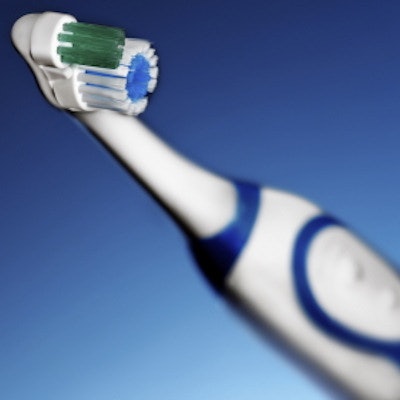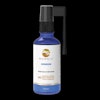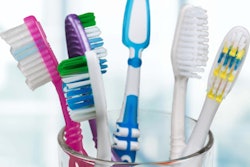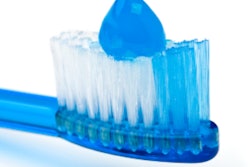
What's the best way to improve oral hygiene in nursing home residents? And what's the answer to the age-old question of whether manual or electronic toothbrushes should be used? Researchers investigated in a new study.
Extending what was initially a two-month study, they examined oral hygiene in nursing home residents one year after providing them with hygiene instruction, either type of toothbrush, and toothpaste. The researchers found that improvements initially seen in the study participants at two months were sustained after one year.
"The results suggest that this simple and time-efficient effort has a positive effect on dental hygiene in nursing home residents over a longer period of time," the authors wrote (Acta Odontologica Scandinavica, December 14, 2017).
They were led by Katrine Gahre Fjeld, PhD, a specialist dentist in the department of clinical dentistry at the University of Oslo Faculty of Dentistry in Norway.
Choose your own toothbrush
Previous studies have found that nursing home residents have extensive plaque associated with poor oral hygiene. Restorations also are common in nursing home patients and they accumulate more plaque than sound enamel, while other factors, such as the presence of physical limitations, multiple medical conditions, hyposalivation, and the use of multiple medications, can make maintaining optimal dental hygiene challenging, the authors noted.
In a precursor study to the current one, the researchers randomized 204 residents of nine nursing homes to use an electric or manual toothbrush for two months, with the same instructions given to both groups. The two groups experienced a significant improvement in oral hygiene but no differences between them in plaque reduction, as measured with the Simplified Oral Hygiene Index (European Journal of Oral Sciences, April 2014, Vol. 122:2, pp. 142-148).
“This simple and time-efficient effort has a positive effect on dental hygiene in nursing home residents.”
To find out if the improvements seen in that study endured over a longer period, the researchers performed the current study with 180 of the original participants who were examined at two months. The participants were then offered the choice of a new electric oscillating rotating toothbrush (Oral B Professional Care 1000, Procter & Gamble) or standard soft manual toothbrush (123 Indicator, Procter & Gamble), regardless of their original group assignment, along with sodium fluoride sensitive toothpaste (Oral-B Sensitive, Procter & Gamble).
"Hence, the participants were back in 'real-life settings,' where dental routines and equipment were adjusted to individual preferences and availability," the authors wrote.
The researchers had no further contact between the study participants or nursing home nurses until follow-up at one year from baseline on a day not known in advance to the participants or nurses.
The original participants were required to have at least six natural teeth and have been admitted to long-term care. Between the two-month and one-year visits, 49 participants had died. At one year, 31 participants were too ill to be examined or had moved to another nursing home. So for the follow-up at one year, the researchers were able to examine 100 of the 180 original study participants.
The mean age of those examined at one year was 86.6 years. Their mean number of natural teeth was 18.8, and 15 participants had removable dentures. More than half of them (51.7%) received assistance with dental hygiene.
Among them, 20 of 50 individuals randomized to a manual toothbrush in the first study and 24 of 50 randomized to an electric toothbrush chose to switch toothbrush types. The researchers found no differences in baseline variables related to toothbrush type preference. The variables included age, gender, length of long-term care residency, number of medical diagnoses, number of prescriptions used, body mass index, nutritional status and weight loss, activities of daily living functions, cognitive impairment, handgrip strength, and mouth dryness.
At one year, 52% of the participants had moderately to seriously impaired cognitive function, and 78.1% had several diagnoses. Their mean handgrip strength was lower, demonstrating that they were frail and had lower strength in muscles that are important for proper dental cleaning.
The mean Simplified Oral Hygiene Index plaque score at one year was 0.7, compared with 0.9 at two months and 1.2 at baseline. The mean reduction was 0.46. The score was reduced in 82% of participants, and 47% had good dental hygiene, according to the index cutoff points.
| Number of participants with improved plaque scores at follow-up | |||
| Baseline | 2 months | 1 year | |
| Good | 17 | 29 | 47 |
| Acceptable | 68 | 69 | 50 |
| Unacceptable | 15 | 2 | 3 |
Plaque reduction was not significantly different between electric and manual toothbrush users at one year (p = 0.47). Additionally, the researchers found no significant differences between participants who brushed their teeth on their own and those who brushed with assistance.
The only baseline factor that was associated with a change in plaque scores was plaque score at baseline, with a higher plaque level at baseline associated with a greater reduction at one year (p < 0.001).
"This suggests that increased focus on the need for assistance, and commitment to a basic initiative, like making manual and electric toothbrushes available, yield substantial oral health benefits, regardless of general health conditions of patients," the authors wrote.
Bias possible
For study limitations, the authors noted that some selection bias was possible, since the nursing home's nurses provided information about the study and invited residents to participate, and highly motivated nurses may have drawn more participants than less motivated ones. Additionally, more motivated residents may have chosen to participate in the study, which may have influenced its effects.
Including another nursing home as a control might have been helpful, the authors noted. They recommended interpreting the study's results with caution.
"Focus on toothbrushing and individually chosen toothbrushes have a beneficial long-term effect on dental hygiene in a frail population irrespective of background factors," they concluded. "Both manual and electric toothbrush should be available in nursing homes."



















